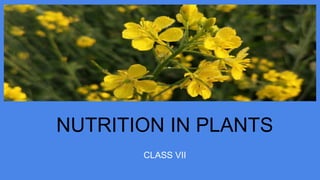
Nutrition in plants
- 1. NUTRITION IN PLANTS CLASS VII
- 2. WHAT DO YOU MEAN BY NUTRITION ? Nutrition is the mode of taking food by an organism and its utilisation by the body. ● Nutrition is very important as the nutrients from the food consumed enables living organisms to build their bodies and grow. ● Nutrition helps to repair damaged parts and organs. ● Nutrition also provides energy for carrying out various functions.
- 3. Organisms that make food themselves are called autotrophs.(Auto = self ; trophe = nutrition) ● Plants are an example of autotrophs as they make their own food using carbon dioxide, water and light energy. Organisms that rely on others and usually take in ready-made food made by the autotrophs are called heterotrophs.(hetero = others) ● Animals and human beings are an example of heterotrophs as they depend on plants in many ways for their food. MODES OF NUTRITION
- 4. PHOTOSYNTHESIS The process by which green plants prepare their food by using carbon dioxide and water in presence of sunlight is called photosynthesis. Oxygen and water vapour are released as by - products. Carbon dioxide +water -------------> carbohydrate + oxygen + water vapour RAW MATERIALS FOR PHOTOSYNTHESIS Sunlight chlorophyll ● Carbon-dioxide : from the air ● Water : from the soil
- 5. PHOTOSYNTHESIS ● The initial product of photosynthesis is a carbohydrate - glucose which gets converted to starch. Q. How do plants get nitrogen for photosynthesis? Nitrogen is present in the soil , convert gaseous nitrogen into its usable form which is soluble and is , therefore ,absorbed by roots along with water. Roots are also able to absorb nitrogenous compounds, present in fertilisers, that are added to the soil.
- 6. Q. Photosynthesis is a unique process. Explain . It supplies food, directly or indirectly for all living organisms. The energy of the sun , thus gets passed on to all organisms through plants. Plants also provide oxygen , needed by all living organisms for respiration. Q. There are some plants which don’t have green leaves like red cabbage, coleus then how do they perform the process of photosynthesis? Some plants have leaves that are not green in colour. Such leaves contains chlorophyll but the green colour is masked due to the presence of the other coloured pigments. However, such leaves can still perform photosynthesis.
- 7. OTHER MODES OF HETEROTROPHIC NUTRITION Parasite Saprotroph ● The organism that grows on the body of another organism and derives nutrients from it. ● The organism that obtains nutrients from the dead and decaying organic matter. ● They take the ready made food from the host. ● They take the digested and decayed food. ● They directly feed on living organisms for their nutrition. ● They feed on dead and decaying organism. ● Example - Cuscuta and orchids. ● Examples - Fungi and some Bacteria.
- 8. PARASITIC MODE OF NUTRITION SAPROPHYTIC MODE OF NUTRITION
- 9. MODES OF NUTRITION FOR OTHER ORGANISMS *Saprotrophic mode of nutrition ‘Sapros’ means rotten and ‘trophic’ means food. Saprotrophic nutrition is the process in which the organisms feed on dead and decaying matter. The food gets digested outside the cells, or sometimes even outside the body of the organisms. This type of digestion is called extracellular digestion. The organism secretes digestive juices directly onto the food. These digestive juices make the food soluble; the organism then directly absorbs it. Such organisms are Rhizopus(bread mould) , Mucor (pin mould) , yeast , Agaricus (mushroom) and many bacteria.
- 10. *Symbiotic relationship Sometimes two organisms live in association and develop a relationship that is beneficial to both. This is called symbiotic relationship. (symbion = to live together) Lichen is a living partnership between a fungus and an alga. The fungus absorbs water and provides shelter. The alga prepares food by photosynthesis. Rhizobium is a bacterium that lives in the roots of leguminous plants. It converts nitrogen , from the atmosphere , into a usable form that can be used by the plants. The plant in return provide food and shelter to the bacterium
- 11. ❖ How are Nutrients Replenished in the Soil ? SOIL Bacteria like Rhizobium Manures Fertilisers Decomposition of dead parts of organisms The soil needs to be continuously replenished to remain productive